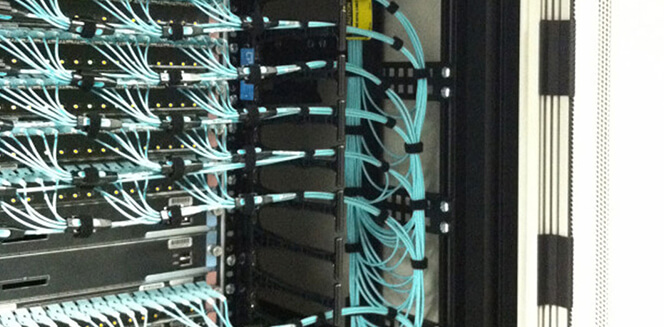Cable Management System: The Core of Every Data Center

26 Apr
2016
Cable management refers to installation of cables and electronic devices for effective data transfer and communication. It plays major role in distribution of power, providing safety, and electricity transmission. With advancements in technology, systems are equipped with cable trays, optical fiber channels, raceways, conduits, and others along with variety of features. The reduction in deployment time of systems, optimization of cable bandwidth, and maximization of cable density is possible with the help of cable management systems. It also provides network reliability, protection to wires, and improved performance with bend radius protection.
Planning of cabling infrastructure:
The first step to deploy any efficient system is planning. The assessment of media used for data transmission and availability of cabling types is essential for deploying a new infrastructure or upgradation of existing infrastructure. Implementation of both, copper and fiber media, is significant as each medium has its own characteristics. Structured method should be used for cable organizer as it simplifies the design and provides flexibility for additional connections. Industry cabling standards should be preferred as they are designed for the protection of end user. In addition, they are able to provide coherent infrastructure and better cabling performance. In the last step of planning, color codes should be used for easier visual identification. It saves a lot of time by simplifying the design and eliminating need to trace cables.
More reports on semiconductor
Cabling components:
To avoid future cabling issues, it is important to select the right combination of cabling components. Each component has certain advantages and disadvantages, variation in costs, and level of compatibility. There are certain factors, such as ease of installation, compatibility, cost, density, flexibility, durability, and others should be considered while purchasing a particular combination. A wide array of components, such as patch cords, data cables, panels, and others is available in the market. In addition, vertical cable managers, horizontal cable managers, overhead cable pathways, cable ties, and others should be implemented as per the requirement of cabling infrastructure.
Cable management practices:
A set of guidelines should be established and implemented for efficient wire management. During installation process, mounting cable that blocks access to other cabling components should be avoided. Furthermore, over-bundling and placing multiple cables on each other should be avoided as it reduces the performance. In daily practices, exposure to direct sunlight and areas of condensation should be avoided. Using correct length patch cables, maintaining cable documentation, maintaining spare patch cords, removal of abandoned cable should be promoted.
The strongest foundation for the network technology should be chosen as per the present and future needs. The structured approach and proper daily practices would ensure the efficient working of cables. There are multiple solutions for every environment and cable management plays vital part in successful deployment of cabling infrastructure.
A report published on the cable management market states that the market would reach $25.1 billion by 2022 and expected to grow at a CAGR of 12.4% from 2016 to 2022. Analysts studying the market have presented an extensive analysis of changing market trends, SWOT analysis & value chain analysis of key manufacturers, drivers & challenges, and economic impact on the industry.

Akhilesh Prabhugaonkar
Author's Bio- Akhilesh Prabhugaonkar holds a bachelor’s degree in Electronics Engineering from the reputed Vishwakarma Institute of Technology. He has a special interest in the fields of forensics, world history, international relations and foreign policy, sports, agriculture, astronomy, security, and oceanography. An ardent bibliophile and melophile, Akhilesh loves to write on topics of his interest and various other societal issues. This love for writing made him enter the professional world of content writing and pursue his career in this direction.
Avenue: Entire Library membership of Allied Market Research Reports at your disposal
- Avenue is an innovative subscription-based online report database.
- Avail an online access to the entire library of syndicated reports on more than 2,000 niche industries and company profiles on more than 12,000 firms across 11 domains.
- A cost-effective model tailored for entrepreneurs, investors, and students & researchers at universities.
- Request customizations, suggest new reports, and avail analyst support as per your requirements.
- Get an access to the library of reports at any time from any device and anywhere.
Related Post
-
How are Submarine Cables Transforming Global Connectivity with Enhanced User Experience?
-
Endoscopy Procedures: Transformations in Techniques and Applications
-
AI-Powered Video Analytics: How the Product Actually Works for enterprises
-
Painting Robots: Transforming Precision Coating and Creative Applications
-
Innovations in Pharmacovigilance Systems Advancing Patient Safety
-
Understanding Edge Security: Keeping Data Safe Near the Source
-
Exploring the Use and Advancements of 3D Laser Scanners in Professional Applications
-
Reinforcing Industrial Controls with Smarter Tools and Training








